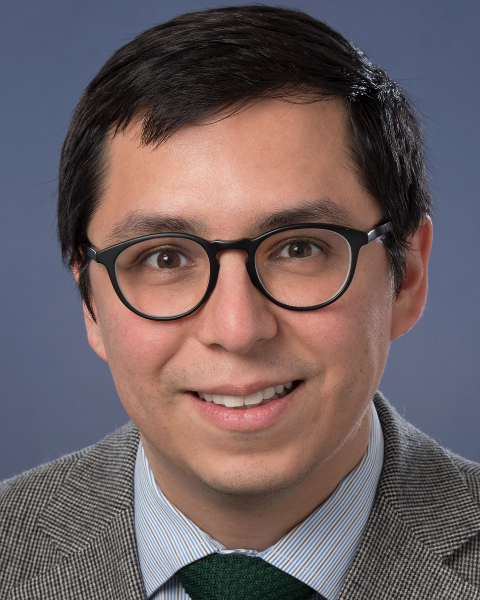PQA 07 - PQA 07 Gastrointestinal Cancer and Sarcoma/Cutaneous Tumors Poster Q&A
3050 - Implementation and Early Outcomes of Stereotactic Body Radiotherapy for Treating Hepatocellular Carcinoma at a Latin American Institution
Tuesday, October 1, 2024
12:45 PM - 2:00 PM ET
Location: Hall C
Screen: 22

Pablo Munoz Schuffenegger, MD
Pontificia Universidad Catolica de Chile
Santiago, Region Metropoli
Presenter(s)
P. Munoz Schuffenegger1, J. M. Gonzalez1, G. Antunez1, C. Besa2, A. Huete2, R. El Far3, A. Virolde4, M. Arrese5, L. A. Diaz5, A. Soza5, N. Jarufe6, S. Mondaca7, B. Nervi7, L. Meneses2, P. Reyes1, and E. F. Vines1; 1Radiation Oncology Unit, Department of Hematology - Oncology, Pontificia Universidad Catolica de Chile, Santiago, Chile, 2Department of Radiology, Pontificia Universidad Catolica de Chile, Santiago, Chile, 3Medical Physics Unit, Centro de Cancer UC, Pontificia Universidad Catolica de Chile, Santiago, Chile, 4Centro de Cancer, Pontificia Universidad Catolica de Chile, Santiago, Chile, 5Department of Gastroenterology, Pontificia Universidad Catolica de Chile, Santiago, Chile, 6Department of Digestive Surgery, Pontificia Universidad Catolica de Chile, Santiago, Chile, 7Medical Oncology Unit, Department of Hematology - Oncology, Pontificia Universidad Catolica de Chile, Santiago, Chile
Purpose/Objective(s): Stereotactic Body Radiotherapy (SBRT) represents an effective treatment modality for treating hepatocellular carcinoma (HCC), its efficacy has been proven in different clinical trials and is now supported by several international guidelines. However, to this date, there are no significant reports on its implementation and use in limited resources settings, particularly in Latin America. The purpose of this study is to describe the implementation and early outcomes of patients with HCC treated with SBRT at a Latin American institution. Materials/
Methods: Patients with HCC treated with SBRT, with curative intent, from October 2018 to September 2023 were analyzed as part of an IRB-approved retrospective cohort study. Patients who had extrahepatic disease or previous liver transplant were excluded. Demographical, clinical, and treatment variables were analyzed.
Results: 109 eligible patients with HCC were treated with SBRT in the study period. Median age was 73 years (range: 53 to 92 years). All patients had liver cirrhosis, and the cause of liver disease was metabolic dysfunction associated steatotic liver disease (MASLD) in 87 patients, and alcohol-liver disease in 12 patients. Baseline Child-Pugh (CP) score was A5 in 67%, A6 in 18%, and B7 or more in 15%. Most patients (78%) had a single HCC, and median lesion size was 4.9 cm (range: 0.4 to 15 cm.), 12 patients had vascular invasion. Median SBRT dose was 35 Gy (range: 27.5 to 50 Gy) in 5 fractions. Median overall survival (OS) was 39,6 months (range: 3 to 50.04 months), local control at 1 year was 87% (95% CI: 81,9 to 96,0%), and disease-free survival at 1 year was 73,29% (95% CI: 65,51 to 83,68%); 7 patients have undergone liver transplantation after SBRT. In 97 patients evaluable for long-term toxicity, 3 patients developed GI bleeding possibly related to SBRT at 3 and 9 months, and 12 had worsening of CP class of two more points at three months after SBRT.
Conclusion: To our knowledge, this is the largest cohort study on the implementation of and early outcomes of SBRT for treating HCC in limited resources settings, particularly in Latin America, where MASLD represents the leading cause of liver disease. Our results emphasize that, in a selected HCC patient population, SBRT represents an effective treatment modality with OS and local control comparable with reports from the developed world. Future studies should focus on cost-effectiveness and increasing access to treatment in limited resources settings.
Purpose/Objective(s): Stereotactic Body Radiotherapy (SBRT) represents an effective treatment modality for treating hepatocellular carcinoma (HCC), its efficacy has been proven in different clinical trials and is now supported by several international guidelines. However, to this date, there are no significant reports on its implementation and use in limited resources settings, particularly in Latin America. The purpose of this study is to describe the implementation and early outcomes of patients with HCC treated with SBRT at a Latin American institution. Materials/
Methods: Patients with HCC treated with SBRT, with curative intent, from October 2018 to September 2023 were analyzed as part of an IRB-approved retrospective cohort study. Patients who had extrahepatic disease or previous liver transplant were excluded. Demographical, clinical, and treatment variables were analyzed.
Results: 109 eligible patients with HCC were treated with SBRT in the study period. Median age was 73 years (range: 53 to 92 years). All patients had liver cirrhosis, and the cause of liver disease was metabolic dysfunction associated steatotic liver disease (MASLD) in 87 patients, and alcohol-liver disease in 12 patients. Baseline Child-Pugh (CP) score was A5 in 67%, A6 in 18%, and B7 or more in 15%. Most patients (78%) had a single HCC, and median lesion size was 4.9 cm (range: 0.4 to 15 cm.), 12 patients had vascular invasion. Median SBRT dose was 35 Gy (range: 27.5 to 50 Gy) in 5 fractions. Median overall survival (OS) was 39,6 months (range: 3 to 50.04 months), local control at 1 year was 87% (95% CI: 81,9 to 96,0%), and disease-free survival at 1 year was 73,29% (95% CI: 65,51 to 83,68%); 7 patients have undergone liver transplantation after SBRT. In 97 patients evaluable for long-term toxicity, 3 patients developed GI bleeding possibly related to SBRT at 3 and 9 months, and 12 had worsening of CP class of two more points at three months after SBRT.
Conclusion: To our knowledge, this is the largest cohort study on the implementation of and early outcomes of SBRT for treating HCC in limited resources settings, particularly in Latin America, where MASLD represents the leading cause of liver disease. Our results emphasize that, in a selected HCC patient population, SBRT represents an effective treatment modality with OS and local control comparable with reports from the developed world. Future studies should focus on cost-effectiveness and increasing access to treatment in limited resources settings.
